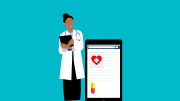In recent years, there has been significant innovation aimed at improving diabetes management and care. Telemedicine, in particular, has been instrumental in reshaping the management of chronic conditions like diabetes. With advancements in areas such as remote monitoring, virtual check-ins and real-time data sharing, telemedicine has improved patient outcomes by increasing the access to care available for patients and supporting the management of chronic conditions.
Particularly in relation to diabetes, healthcare associations recommend improving diabetes care delivery at the systems level, offering self-management support, and using shared decision-making in the care of patients with diabetes. For example, remote monitoring allows the patient to communicate real-time blood glucose data to their physicians to support diabetes self-management and recognise problems early.
Initially developed for the treatment and management of diabetes, many technologies, and its associated intellectual property (IP), can be repurposed for treatment and management of other medical conditions.
From Diabetes to Other Conditions – Repurposing Telemedicine Technologies
Diabetes remains one of the most common and costly conditions to treat globally, with many primary care providers often managing diabetes with limited resources, telemedicine has become an essential tool. The COVID-19 pandemic highlighted telemedicine’s potential to maintain healthcare continuity, but its benefits extend beyond emergency situations.
Continuous Glucose Monitoring devices (CGMs), which monitor and provide detailed information about fluctuations in blood glucose levels, are an integral part of remote monitoring for diabetes care in telemedicine. Patent analysis has shown that between the years 2000 to 2022, over 6,100 patent applications relating to CGMs were filed. This has been associated with the development of new sensors for CGMs, and highlights their importance and commercial value in telemedicine for managing diabetes.
However, the technology used in CGMs can also be applied to manage and treat other health conditions associated with glucose levels, such as obesity, glycogen storage diseases and insulinoma (a rare tumour that releases excess insulin) etc. Recent trends have also shown CGM technology being used in monitoring general health and wellness. For instance, CGMs are being used by people without diabetes as a personal health device to track their glucose concentrations and promote healthier habits such as increased activity, changes in nutrition and sleep habits.
Cardiovascular Care
The versatility of telemedicine technology for managing diabetes is evident in its application to cardiovascular care. CGMs originally designed to monitor glucose levels can also measure other physiological parameters such as blood pressure or blood ketones. Experts also suggest that CGMs can be used during acute cardiovascular events to reduce hyperglycaemic and hypoglycaemic episodes.
One such example is California-based start-up Movano, which has produced a system-on-a-chip (SoC) for glucose and cuffless blood pressure monitoring. The SoC relies on photoplethysmography (PPG) optical technology to monitor blood glucose, and blood pressure levels, providing a comprehensive approach to cardiovascular care.
Respiratory and Mental Health
Telemedicine platforms developed for diabetes management are also being used to manage respiratory conditions such as asthma. These platforms use data from continuously monitoring oxygen levels to evaluate respiratory health and detect early signs of a deteriorating respiratory system in patients. This provides the opportunity for timely intervention and early treatment to better manage chronic respiratory conditions.
Similarly, telemedicine platforms which were initially created to manage chronic diseases such as diabetes (i.e., care delivered via video conferencing) has been increasingly used in managing and treating mental health, also known as telemental health. The patient engagement tools and data-tracking algorithms are being used to monitor behavioural trends and patient’s mental well-being helping clinicians to better support patients suffering from conditions related to mental health.
Accelerating Innovation Through Transferable IP
Adapting and implementing IP in telemedicine across various medical fields can be useful to proprietors in accelerating innovation and reducing development costs. Additionally, repurposing existing Intellectual Property creates new revenue streams for companies.
The evolution of telemedicine technologies from managing chronic conditions such as diabetes to addressing a broader range of health conditions and general wellness illustrates the importance and commercial value of transferable IP in this field. By repurposing existing solutions, digital health companies can provide new services more quickly and cost-effectively, benefiting both patients and healthcare providers. This adaptability contributes to a more integrated approach to healthcare, where technologies designed for one purpose can address a wide range of conditions.
By Ahmad Hussain, Technical Assistant at intellectual property law firm, Reddie & Grose





